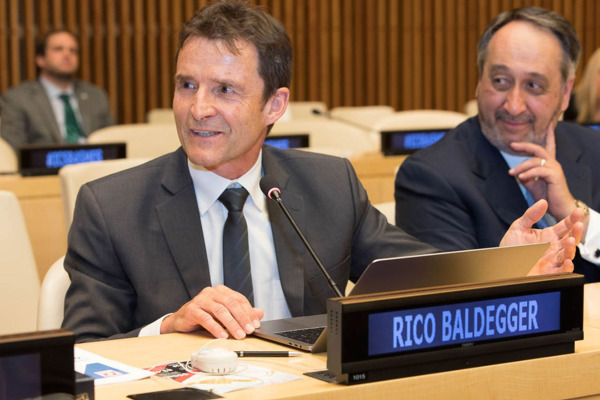12. Aug 2019
Article published in the ICBS Gazette, written by Prof Rico J. Baldegger, Director of the School of Management Fribourg.

According to UNCTAD’s projections, 5 trillion US-dollars per year is the amount needed from the private sector to achieve the Sustainable Development Goals (SDGs) by 2030. And the good news is that according to Google trends (linked to keyword google search “impact investing”), more and more people are willing to invest to achieve these goals as we can see a clear rise of interest in impact investing. So, it is without a doubt that we’ve seen a growing allocation of funding toward impact investing. Now, despite the growing interest and commitments, the amount allocated toward impact investing is still low when you have in mind the number of 5 trillion US-Dollars to invest per year. When you look into the 1.3 trillion US-dollar assets under management of Goldman Sachs, less than 1% is allocated toward impact. "5 trillion US-dollars per year is the amount needed from the private sector to achieve the Sustainable Development Goals (SDGs) by 2030." But we’re at the right time, where it can move faster! If efforts are globally coordinated. Because the new generation, where the money will be coming from, is pushing by investing and building toward solving these global challenges. The younger generation sees their investment decisions as a way to express their social, political and environmental values. I hope the young generation in this room agrees to it and shows action. It’s no longer simply about making money, it’s also about having a purpose and this socially responsible mindset is not simply anecdotal. The impact investing trends mentioned before and success stories on the market do prove that there is an “ROI to funding a cause”. And not only does the younger generation believe that profit and purpose go hand in hand, it is also a generation of entrepreneurs.
Indeed, this generation is witnessing first-hand the leapfrogging happening in their markets, which has reinforced an “it’s possible attitude” gradually shifting the mindset so that becoming an entrepreneur is a sign of success and a path to making change possible! So, on one hand, you have the rising interest of impact investing and, on the other hand, you have the rise in power of the new generation doing business with a purpose. Now, what is the status on emerging market opportunities? Despite representing 85% of the world population, emerging markets have received 56% of the impact funding. And even if this is an important allocation, we believe much more can be allocated to these markets. But for that we need more and better investment opportunities. Indeed, looking at our analysis, the number and the quality of companies created is still too low in emerging markets because the startup ecosystems are still too nascent (for different environmental factors from ease of doing business to market opportunity) making it difficult for these same ecosystems to absorb more capital. So, what becomes clear to us is that in order to create more opportunities, we need to create more mature startup ecosystems. But how do we support building a startup ecosystem? To do that, we need to look at the basics of the startup cycle. It goes from having an idea, struggling through the valley of death, reaching the break-even stage and finally growing exponentially. And during each phase, we can work to support entrepreneurs.
The School of Management Fribourg uses various instruments to support and develop ecosystems, together with partners like Seedstars or Ashoka. And it can start as simply as creating awareness, inspiring and making connections through launchpads, hackathons or events, like the Seedstars World competition, to transferring the right skills and tools, to building and accelerating ventures through programs, such as an accelerator or incubator. “Now, to be clear, I am not saying that all entrepreneurs need to participate in all these initiatives, and that all these initiatives are good, but they make a significant difference, especially in these nascent ecosystems where fundraising is extremely difficult. So, in many ways, we’ve been working on helping build these ecosystems with our partners in order to support entrepreneurs to increase the pipeline with more and better investment opportunities, which will generate more capital inflow, and hopefully, a virtuous cycle will take place.
Thus, a nascent ecosystem needs - necessity and opportunity entrepreneurship - adaptive digitalization with digital artifacts, digital platforms and digital infrastructures, and - education with adaptive technology as a solution As an example, the School of Management Fribourg supports educational start-ups with a digital flavor in emergent markets. Right now, the company serves over 80,000 students, 40,000 parents, and 12,000 educators in 17 states in Nigeria. www.edves.net
Or In 2019; SchoolApp from the Democratic Republic of the Congo: During the growth program, SchoolAp grew (that is, the number of students registered) by an average of 14% per week. Between January and March the number of students registered increased from 50,000 to 140,000. Pascal, the CEO, told me that “The Edtech prize opened the door to new opportunities. Thanks to the award, they met the President of the Republic, who recommended our project to the Ministry of Education with whom we are signing a partnership for 23,000,000 students. We have also been approached by a multitude of local and international investors and have a large partnership in progress with the largest bank in the country (Rawbank) which will not only sponsor the production of educational content but also the global financing of SchoolApp and its development.”


